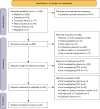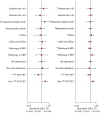Diagnostic accuracy of glioma pseudoprogression identification with positron emission tomography imaging: a systematic review and meta-analysis
- PMID: 37581048
- PMCID: PMC10423382
- DOI: 10.21037/qims-22-1340
Diagnostic accuracy of glioma pseudoprogression identification with positron emission tomography imaging: a systematic review and meta-analysis
Abstract
Background: Positron emission tomography (PET) imaging is a promising molecular neuroimaging technique and has been proposed as one of the criteria for glioma management. However, there is some controversy concerning the diagnostic accuracy of PET using different radiotracers to differentiate between glioma pseudoprogression (PsP) and true progression (TPR). The purpose of this meta-analysis was to systematically evaluate the methodological quality and clinical value of original studies for distinguishing PsP from TPR in glioma.
Methods: The Medline, Web of Science, Embase, Cochrane Library, and ClinicalTrials.gov were searched from inception until September 1, 2022. Retrieved clinical studies only investigated the PsP cases but did not include the cases of radiation necrosis or other treatment-related changes. Eligible studies were screened for data extraction and evaluated by 2 independent reviewers using the Quality Assessment of Diagnostic Accuracy Studies 2 (QUADAS-2) tool. A random effects model was used to describe summary receiver operating characteristics. Meta-regression and subgroup analyses were applied to identify any sources of heterogeneity.
Results: The meta-analysis included 20 studies, comprising 317 (30.9%) patients with PsP and 708 (69.1%) with TPR. The summary sensitivity and specificity of general PET for identifying PsP were 0.86 [95% confidence interval (CI): 0.77-0.91] and 0.84 (95% CI: 0.79-0.88), respectively. The statistical heterogeneity was explained by sample size, study design, World Health Organization (WHO) grade, gold standard, and radiotracer type. The summary sensitivity and specificity of O-(2-18F-fluoroethyl)-L-tyrosine (18F-FET PET) were 0.80 (95% CI: 0.68-0.88) and 0.81 (95% CI: 0.75-0.85), respectively. The maximum tumor-to-brain ratio (TBRmax) and the mean tumor-to-brain ratio (TBRmean) both showed excellent diagnostic performance in 18F-FET studies, the summary sensitivity was 0.83 (95% CI: 0.72-0.91) and 0.79 (95% CI: 0.65-0.98), respectively, and the specificity was 0.76 (95% CI: 0.68-0.84) and 0.78 (95% CI: 0.64-0.88), respectively.
Conclusions: PET imaging is generally accurate in identifying glioma PsP. Considering the credibility of meta-evidence and the practicability of using radiotracer, 18F-FET PET holds the highest clinical value, while TBRmax and TBRmean should be regarded as reliable parameters. PET used with the radiotracers and multiple-parameter combinations of PET with magnetic resonance imaging (MRI) and radiomics analysis have broad research and application prospects, whose diagnostic values for identifying glioma PsP warrant further investigation.
Keywords: Glioma; meta-analysis; positron emission tomography (PET); pseudoprogression (PsP); true glioma progression.
2023 Quantitative Imaging in Medicine and Surgery. All rights reserved.
Conflict of interest statement
Conflicts of Interest: All authors have completed the ICMJE uniform disclosure form (available at https://qims.amegroups.com/article/view/10.21037/qims-22-1340/coif). The authors have no conflicts of interest to declare.
Figures






References
-
- Wen PY, Macdonald DR, Reardon DA, Cloughesy TF, Sorensen AG, Galanis E, Degroot J, Wick W, Gilbert MR, Lassman AB, Tsien C, Mikkelsen T, Wong ET, Chamberlain MC, Stupp R, Lamborn KR, Vogelbaum MA, van den Bent MJ, Chang SM. Updated response assessment criteria for high-grade gliomas: response assessment in neuro-oncology working group. J Clin Oncol 2010;28:1963-72. 10.1200/JCO.2009.26.3541 - DOI - PubMed
-
- Galldiks N, Kocher M, Ceccon G, Werner JM, Brunn A, Deckert M, Pope WB, Soffietti R, Le Rhun E, Weller M, Tonn JC, Fink GR, Langen KJ. Imaging challenges of immunotherapy and targeted therapy in patients with brain metastases: response, progression, and pseudoprogression. Neuro Oncol 2020;22:17-30. 10.1093/neuonc/noz147 - DOI - PMC - PubMed
LinkOut - more resources
Full Text Sources
Miscellaneous
